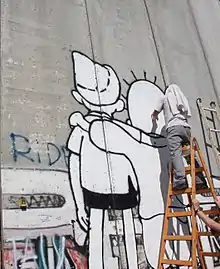The Peace Kids (mural)
The Peace Kids is a mural in Tel Aviv, Israel by Moodi Abdallah, Roman Kozhokin, Itai Froumin and Jonathan Kis-Lev. A copy of the work, which depicts Israeli Srulik and Palestinian Handala embracing one another, exists on the Israeli West Bank barrier and was created with the cooperation of local Palestinian artists.[1]

History

In 2013 Kis-Lev joined hands with three artists: Palestinian Moodi Abdallah, and Israeli Roman Kozhokin and Itai Froumin. Froumin helped Kis-Lev creating the final image of the embrace, properly showing Srulik from the back, while keeping his iconic hair twirl showing. Artist Roman Kozhokin helped creating the stencil and spraying the work in Tel Aviv. Artist Moodi Abdallah helped creating the work in Bethlehem.
Srulik (Hebrew: שרוליק, IPA: [ˈsʁulik]) is a cartoon character symbolizing Israel. The character was created in 1956 by the Israeli cartoonist Kariel Gardosh, known by his pen name Dosh. The cartoon appeared for many years in the newspaper Maariv.
Handala, also known as Handhala (Arabic: حنظلة), is the most famous caricature by Palestinian cartoonist Naji al-Ali. Al-Ali has been described as the greatest Palestinian cartoonist and probably the best-known cartoonist in the Arab world.
Reception and criticism
The work was received with mixed criticism. It was called "naive" and "delusional" by both Israeli and Palestinians. Left wing activists lauded the work for its simplicity, conveying a "message of hope."[2]
Israeli artist and Bezalel Academy of Arts professor Michel Kichka praised the work:
"I, too, have seen this large-scale graffiti in South Tel Aviv. It is doubtful whether such a painting could have been created in the lives of Al-Ali and Dosh. Dosh was a nationalist right-wing, Ali was opposed to Israel's very existence. Nevertheless, the naive painting has a spirit of reconciliation and brotherhood that warms the heart."[3]
The work was considered "An optimistic piece" according to Forward Magazine.[4]
See also
References
- "יהונתן כיס-לב מספר על אמנות הרחוב מעוררת המחלוקת". Kan, Israeli Art Magazine - מגזין כאן: מציאות ישראלית באמנות. 36. February 2015.
- Kampinski, Zipa, Brilliance at Frenkel Street – Together All the Way (in Hebrew), Xnet Yediot Aharonot, retrieved 1 October 2014
- "קריקטורות מתפייסות - Cartoons reconcile". מישל קישקה Michel Kichka (in Hebrew). 2016-07-16. Retrieved 2018-04-21.
- Zeveloff, Naomi (7 August 2016), Take a Tour with the Graffiti Geek of Tel Aviv — and Learn Hebrew, Too, Forward Magazine, retrieved 1 November 2017